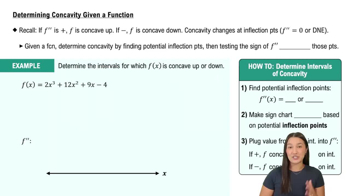Here are the essential concepts you must grasp in order to answer the question correctly.
Second Derivative Test
The second derivative test is a method used to determine the concavity of a function. If the second derivative, ƒ''(x), is positive on an interval, the function is concave up on that interval. Conversely, if ƒ''(x) is negative, the function is concave down. This test helps identify the nature of the curvature of the graph of the function.
Recommended video:
The Second Derivative Test: Finding Local Extrema
Critical Points
Critical points are values of x where the first derivative, ƒ'(x), is either zero or undefined. These points are essential for analyzing the behavior of the function, as they can indicate potential local maxima, minima, or points of inflection. To determine concavity, we often need to find critical points of the second derivative.
Recommended video:
Intervals of Concavity
Intervals of concavity refer to the ranges of x-values where a function is either concave up or concave down. By analyzing the sign of the second derivative across the critical points, we can establish these intervals. Understanding these intervals is crucial for sketching the graph of the function and predicting its behavior.
Recommended video:
Determining Concavity Given a Function
 Verified step by step guidance
Verified step by step guidance Verified video answer for a similar problem:
Verified video answer for a similar problem:



 6:38m
6:38m